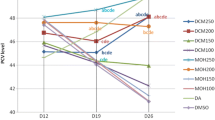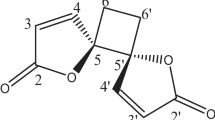Abstract
Parasitic diseases have an enormous health and economic impact and are a particular problem in tropical regions of the world. Disease caused by protozoa, such as trypanosomiasis, are the cause of most parasite related morbidity and mortality. Thus, the aim of this study was to verify the trypanocidal effectiveness of Lippia alba and Lippia origanoides against Trypanosoma evansi in vitro and in vivo. L. alba and L. origanoides were used in vitro on trypomastigotes at different concentrations (0.5, 1.0 and 2.0 %) and exposure times (0, 1, 3, 6 and 9 h). The three concentrations tested showed trypanocidal activity in vitro, completely eliminating the parasites in small concentration after 6 h of assay. In vivo tests were performed using mice as the experimental model. T. evansi infected mice were treated with L. alba and L. origanoides with dose of 1.5 mL kg−1 during 5 days. These protocols did not provide curative efficacy, however the mice treated with L. origanoides showed a significant increase in the longevity when compared to control group. Active compounds present in essential oils, such as L. origanoides, may potentiate the treatment of trypanosomosis when associated with other trypanocidal drugs.

Similar content being viewed by others
References
Adams RP (1995) Identification of essential oil components by gas chromatography/mass spectroscopy. Allured Publishing Corporation, Illinois
Andrews KT, Fisher G, Skinner-Adams TS (2014) Drug repurposing and human parasitic protozoan diseases. Int J Parasitol Drugs Drug Resist 4:95–111
Baldissera MD, Da Silva AS, Oliveira CB, Zimmermann CEP, Vaucher RA, Santos RCV, Rech VC, Tonin AA, Giongo JL, Mattos CB, Koester L, Santurio JM, Monteiro SG (2013) Trypanocidal activity of the essential oils in their conventional and nanoemulsion forms: in vitro tests. Exp Parasitol 134:356–361
Baldissera MD, Da Silva AS, Oliveira CB, Santos RCV, Vaucher RA, Raffin RP, Gomes P, Dambros MGC, Miletti LC, Boligon AA, Athayde ML, Monteiro SG (2014) Trypanocidal action of tea tree oil (Melaleuca alternifolia) against Trypanosoma evansi in vitro and in vivo used mice as experimental model. Exp Parasitol 141:21–27
Baltz T, Baltz D, Giroud C, Crockett J (1985) Cultivation in a semi-defined medium of animal infective forms of Trypanosoma brucei, T. equiperdum, T. evansi, T. rhodesiensi and T. gambiense. EMBO J 4:1273–1277
Berlin D, Loeb E, Baneth G (2009) Disseminated central nervous system disease caused by Trypanosoma evansi in a horse. Vet Parasitol 161:316–319
Borges AR, Aires JR, Higino TM, Medeiros MCF, Citó AMGL, Lopes JAD, Figueiredo RCBQ (2012) Trypanocidal and cytotoxic activities of essential oils from medicinal plants of Northeast of Brazil. Exp Parasitol 132:123–138
Brun R, Hecker H, Lun ZR (1998) Trypanosoma evansi and T. equiperdum: distribution, biology, treatment and phylogenetic relationship (a review). Vet Parasitol 79:95–107
Colpo CB, Monteiro SG, Stainki DR, Colpo ETB, Henriques GB (2005) Natural infection by Trypanosoma evansi in dogs. Cienc Rural 35:717–719
Da Silva AS, Doyle RL, Monteiro SG (2006) Métodos de contenção e confecção de esfregaço sanguíneo para pesquisa de hemoparasitas em ratos e camundongos. FMVZA 13:83–87
Da Silva AS, Tochetto C, Zanette RA, Pierezan F, Rissi DR, Santurio JM, Monteiro SG (2008) Aceturato de diminazeno e dipropionato de imidocarb no controle de infecção por Trypanosoma evansi em Rattus norvegicus infectados experimentalmente. Cienc Rural 38:1357–1362
Do Carmo GM, Baldissera MD, Vaucher RA, Rech VC, Oliveira CB, Sagrillo MR, Boligon AA, Athayde ML, Alves MP, França RT, Lopes STA, Schwertz CI, Mendes RE, Monteiro SG, Da Silva AS (2015) Effect of Treatment with Achyrocline satureioides (free and nanocapsules essential oil) and diminazene aceturate on hematological and biochemical parameters in rats infected by Trypanosoma evansi. Exp Parasitol 149:39–46
Escobar P, Leal SM, Herrera LV, Martinez JR, Stashenko E (2010) Chemical composition and antiprotozoal activities of Colombian Lippia spp essential oils and their major components. Mem Inst Oswaldo Cruz 105:184–190
Habila N, Inuwa MH, Aimola IA, Udeh UM, Haruna E (2012) Pathogenic mechanisms of Trypanosoma evansi infections. Res Vet Sci 93:13–17
Herrera HM, Davila AM, Norek A, Abreu UG, Souza SS, D’andrea PS, Jansen AM (2004) Enzootiology of Trypanosoma evansi in Pantanal, Brazil. Vet Parasitol 125:263–275
Hoare CA (1972) The trypanosomes of mammals a zoological monograph. Blackwell, Oxford
Kayser O, Kiderlen AF, Croft SI (2003) Natural products as antiparasitic drugs. Parasitol Res 90:S55–S62
Macedo IT, Bevilaqua CM, de Oliveira LM, Camurça-Vasconcelos AL, Vieira LS, Oliveira FR, Queiroz-Junior EM, Tomé AR, Nascimento NR (2010) Anthelmintic effect of Eucalyptus staigeriana essential oil against goat gastrointestinal nematodes. Vet Parasitol 173:93–98
Mikus J, Harkenthal M, Steverding D, Reichling J (2000) In vitro effect of essential oils and isolated mono- and sesquiterpenes on Leishmania major and Trypanosoma brucei. Planta Med 66:366–368
Ming LC, Figueiredo RO, Machado SR, Andrade RMC (1996) Yield of essential oil of and citral content in different parts of lemongrass leaves (Cymbopogon citratus DC.) Stapf Poaceae. Acta Hort 426:555–559
Molina-Garza ZJ, Bazaldúa-Rodríguez AF, Quintanilla-Licea R, Galaviz-Silva L (2014) Anti-Trypanosoma cruzi activity of 10 medicinal plants used in northeast Mexico. Acta Trop 136:14–18
Monzote L, García M, Pastor J, Gil L, Scull R, Maes L, Gille L (2014) Essential oil from Chenopodium ambrosioides and main components: activity against Leishmania, their mitochondria and other microorganisms. Exp Parasitol 136:20–26
Muhammad G, Saqib M, Sajid MS, Naureen A (2007) Trypanosoma evansi infections in Himalayan black bears (Selenarctosthibetanus). J Zoo Wildl Med 38:97–100
Oliveira DR, Leitão GG, Bizzo HR, Lopes D, Alviano DS, Alviano CS, Leitão SG (2007) Chemical and antimicrobial analyses of essential oil of Lippia origanoides H.B.K. Food Chem 101:236–240
Oliveira GT, Ferreira JMS, Rosa LH, De Siqueira EP, Johann S, Lima LAS (2014) In vitro antifungal activities of leaf extracts of Lippia alba (Verbenaceae) against clinically important yeast species. Rev Soc Bras Med Trop 47:247–250
Olivero-Verbel J, Barreto-Maya A, Bertel-Sevilla A, Stashenko EE (2014) Composition, anti-quorum sensing and antimicrobial activity of essential oils from Lippia alba. Braz J Microbiol 45:759–767
Pascual ME, Slowing K, Carretero E, Mata DS, Villar A (2001) Lippia: traditional uses, chemistry and pharmacology: a review. J Ethnopharmacol 76:201–214
Peregrine AS, Mamman M (1993) Pharmacology of diminazene: a review. Acta Trop 54:183–203
Rosa MSS, Mendonça-Filho RR, Bizzo HR, Rodrigues IA, Soares RM, Souto-Padron T, Alviano CS, Lopes AH (2003) Antileishmanial activity of a linalool-rich essential oil from Croton cajucara. Antimicrob Agents Chemother 47:1895–1901
Santos AO, Santin AC, Yamaguchi UM, Cortez LE, Ueda-Nakamura T, Dias-Filho BP, Nakamura SV (2010) Antileishmanial activity of an essential oil from the leaves and flowers of Achillea millefolium. Ann Trop Med Parasitol 104:475–483
Silva RAMS, Seidl A, Ramirez L, Dávila AMR (2002) Trypanosoma evansi e Trypanosoma vivax. Biologia, Diagnóstico e Controle. Embrapa Pantanal, Corumbá
Spinosa HS, Górniak SL, Bernardi MM (1999) Farmacologia aplicada à medicina veterinária. Guanabara Koogan, Rio de Janeiro
Toni C, Becker AG, Simões LN, Pinheiro CG, Silva LL, Heinzmann BM, Caron BO, Baldisserotto B (2014) Fish anesthesia: effects of the essential oils of Hesperozygis ringes and Lippia alba on the biochemistry and physiology of silver catfish (Rhamdia quelen). Fish Physiol Biochem 40:701–714
Ueda-Nakamura T, Mendonça-Filho RR, Morgado-Diaz JA, Maza PK, Dias Filho BP, Cortez DAG, Alviano DS, Rosa MS, Lopes AH, Alviano CS, Nakamura CV (2006) Antileishmanial activity of Eugenol-rich essential oil from Ocimum gratissimum. Parasitol Int 55:99–105
Vera SS, Zambrano DF, Méndez-Sanchez SC, Rodríguez-Sanabria F, Stashenko EE, Luna JED (2014) Essential oils with insecticidal activity against larvae of Aedes aegypti (Diptera: Culicidae). Parasitol Res 113:2647–2654
Wright CW, Phillipson JD (1990) Natural products and the development of selec-tive antiprotozal drugs. Phytother Res 4:127–139
Author information
Authors and Affiliations
Corresponding author
Ethics declarations
Conflict of interest
The authors report no conflicts of interest. The authors alone are responsible for the content and writing of the paper.
Ethical approval
The procedure was approved by the Animal Welfare Committee of Universidade Federal de Santa Maria under number 117/2014.
Rights and permissions
About this article
Cite this article
Baldissera, M.D., de Freitas Souza, C., Mourão, R.H.V. et al. Trypanocidal action of Lippia alba and Lippia origanoides essential oils against Trypanosoma evansi in vitro and in vivo used mice as experimental model. J Parasit Dis 41, 345–351 (2017). https://doi.org/10.1007/s12639-016-0800-7
Received:
Accepted:
Published:
Issue Date:
DOI: https://doi.org/10.1007/s12639-016-0800-7




